We’ve been talking with drone industry experts about what it means to create UAS traffic management (UTM) systems for many years now, with industry and government stakeholders often expressing different opinions about how these ecosystems need to both function and come together. The challenges around enabling a UTM system that can safely enable high-density UAS operations in urban environments and be coordinated with traditional aviation are significant, but so are the opportunities.
While there is disagreement around process and timing, there is consensus around the need for a coordinated approach among numerous stakeholders to truly enable these systems. A better understanding of that kind of coordination is one of the key elements in a new report from PwC that provides strategic insights for key stakeholders. The report details why the world needs UTM, outlines the essential components of the system and defines what’s driving the UTM market. It also highlights new avenues for innovation and growth that this ecosystem will enable across the world.
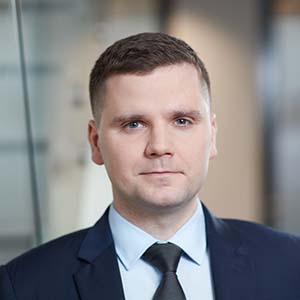
To provide some further context around the information that is laid out in the report, we connected with Aleksander Buczkowski and Tomasz Kłosowicz from the PwC Drone Powered Solutions team. They answered questions relating to the biggest hurdles around a coordinated UTM approach, how they use terms like “UTM” and “U-Space” with different audiences, what additional resources are available and much more.
You can download the full report here.

Jeremiah Karpowicz: How big of a barrier are the costs when it comes to the need for a fundamental shift in aviation infrastructure that your report highlights? Which is to say, is the main barrier to this sort of shift the costs associated with it?
Tomasz: In our opinion, providing initial funding from a government for the development of a national basic UTM capabilities, as well as developing a sustainable UTM governance and financial model, are crucial enablers for the thriving UTM ecosystem in a country.
However, it would be an oversimplification to say that these are the only current challenges identified. In our PwC global UTM report, we highlight other ones as well, while the global assessment of national UTM ecosystems' readiness is what we aim to undertake next.
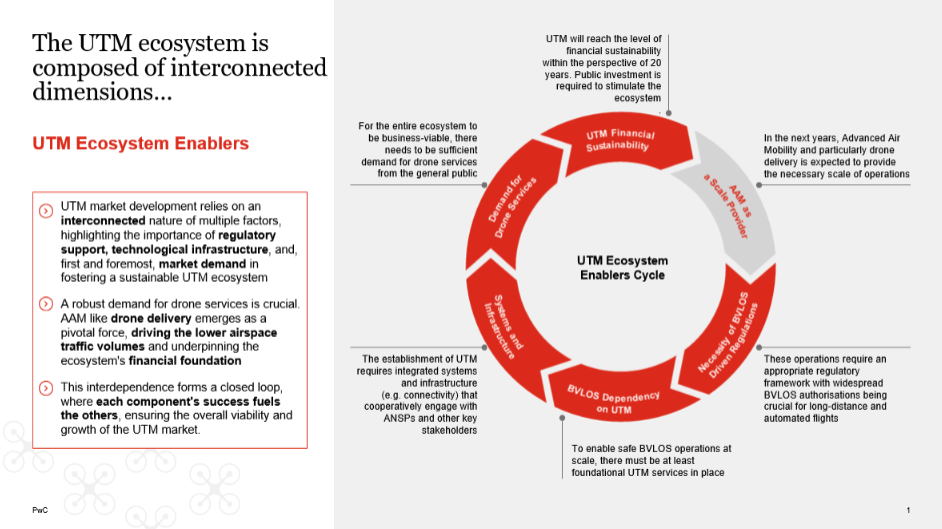
Are the biggest challenges around a better coordinated UTM approach a matter of logistics, culture, personalities, or something else?
Aleksander: The UTM ecosystem is driven by three dimensions: safety, business, and use-cases, each represented by different groups of stakeholders.
For safety, these stakeholders include governments (ministries, Local Administration Units), Civil Aviation Authorities (CAAs) and Air Navigation Service Providers (ANSPs). For business, they include technology and service providers, and for use-cases, they encompass users, clients, citizens, and voters, among others. These three groups often do not speak the same language and have different concerns (such as risk mitigation, commercial scalability, and usefulness while respecting privacy) that need to be discussed and addressed jointly.
The lack of UTM strategies at the national and organisational levels, which would address all these dimensions, is clearly visible. Additionally, limiting the UTM discussion to only technical and operational aspects, while not addressing the business ones crucial for the future self-financing of the UTM ecosystem, hinders its development.
As PwC Global Drone Center of Excellence, we see our role in working on strategic, commercial, and security topics that help move forward and break this paradigm of closed technical and operational discussions among aviation experts only. Furthermore, there are only a few examples of initiatives that gather different views in one place. One such example is the Global UTM Association (GUTMA), which we as PwC Drone Powered Solutions have recently joined.
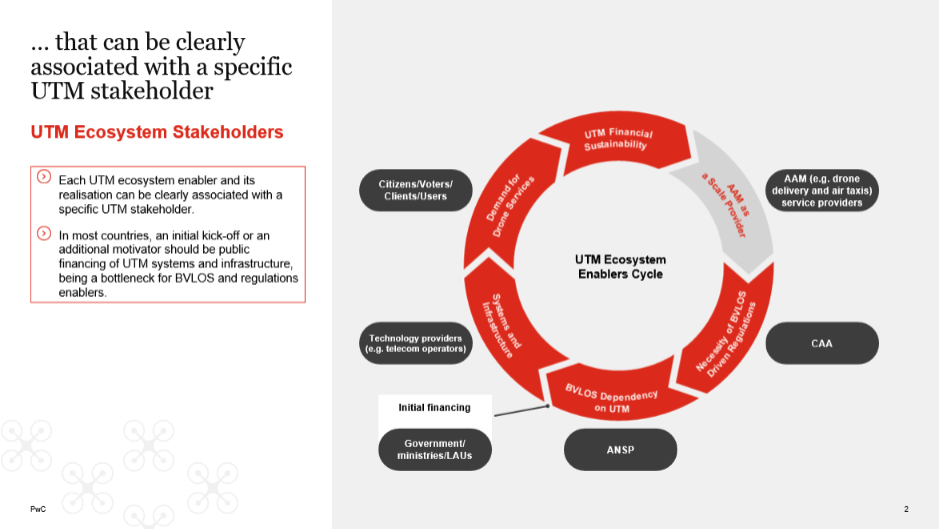
Your report calls out how the need for UTM today is very real given the drone industry’s growth, but which group of stakeholders needs to more fully understand this need? The drone industry itself? Or traditional aviation? Or the general public?
Tomasz: In our PwC global UTM report, we describe the UTM ecosystem and the challenges that UTM stakeholders face. Each of the stakeholders has its homework to do. For regulators it is necessary to adopt business friendly regulatory frameworks or, if they exist, clarify the operational and technical aspects of them. For airspace managers, it is crucial to implement tools for scalable drone (BVLOS) operations. For commercial providers, it is essential to address the needs of users, clients, citizens, and voters.
As for the division between the drone and traditional aviation industry, we believe that this distinction is no longer valid. Both CAAs and ANSPs understand that they represent all airspace users, including commercial airlines, military, General Aviation, as well as drone operators and pilots.
You mention that in Europe, the 'UTM' term is mostly understood as a system rather than an ecosystem. How should anyone focus on enabling a global framework for this technology approach and consider these distinctions?
Tomasz: The fact that in Europe the term UTM is mostly associated with a technological system results from naming the whole ecosystem as U-Space. While working with our clients, we use the terms UTM and U-Space interchangeably, depending on the geographies we operate in.
For further client guidance and clarification, we distinguish between aspects of the UTM ecosystem: stakeholders (as mentioned above), functions (focused on safety, business or use-cases as previously explained), roles (centralised and market-oriented) and services (there are even 44 unique UTM services!). Finally, we differentiate technological systems with their modules and applications.
Your report specifically explores what drives the UTM market, but how much of that activity is based on the expected number of drones in the air versus the brand new opportunities and expectations that the technology will open up? Or are these elements inherently linked?
Aleksander: These elements are inherently linked.
In our PwC global UTM report, we calculated the current and (conservatively) estimated the future number of drone operations globally and for 5 geographical regions by 2029, including market growth and compound annual growth rate. We did this by reflecting official CAAs and ANSPs statistics and operational data, combined with our unique methodologies, to reflect the Advanced Air Mobility services as a scale provider.
In the next few years, UTM backed, AAM of goods and people - particularly drone delivery - is expected to provide the necessary scale of (BVLOS) operations.
What are some of the “next steps” you encourage readers to take after they’ve read your report? How can they best start or continue the conversation when it comes to enabling safe and sustainable UTM ecosystems? What other resources would you point them toward?
Aleksander: First of all, we ask representatives of each UTM stakeholder group (ministries, CAAs, ANSPs, tech and service providers) to examine their role in the UTM ecosystem’s enablers cycle. These enablers or 'shoes to fill', can be clearly associated with specific stakeholders. To better illustrate the entire UTM ecosystem cycle, please have a look at our graphs.
Secondly, we encourage these UTM stakeholders to ask themselves several questions, such as:
- Is there a robust political drone strategy in your country that defines the economic importance of the drone sector, including manufacturers, service providers, and users, while also considering the security and defence aspects?
- Is there a drone governance framework that defines all stakeholders, their roles, financial interdependence, and other crucial factors for UTM ecosystem development? Are the centralised and market oriented roles clearly defined?
- Does your company have a specific strategy or business plan, prepared for bottlenecks that may occur at the level of each UTM ecosystem stakeholder/enabler?
- Has your company fully defined all UTM related business opportunities with a clear vision of pricing models, both cost recovery and commercial, as well as money flow?
Finally, as PwC Drone Powered Solutions, we offer UTM stakeholders a set of tools to help them fulfil their role within the UTM ecosystem. Delivering their part of the work is crucial for a thriving UTM ecosystem, which requires a coordinated approach. We provide strategic advisory at the national and organisational levels to define a UTM master plan consisting of market and organisational readiness assessments, UTM strategy, and UTM implementation roadmap.
Our experience working with public and private clients shows that market assessment is the critical starting point for developing and implementing an effective UTM strategy. More on our consulting tools can be found on our brand new website: www.pwc.com/drones
Aleksander Buczkowski is a Director leading the PwC Drone Powered Solutions – Global Centre of Excellence in Drone and Satellite Technologies. Within the consultancy practice, he focuses on strategic advisory, technology consulting, as well as software and data analytics. Over the years he worked with governments and organizations on 6 continents. He is a licensed BVLOS drone pilot, Master of Science in Geospatial Technologies, and an MBA graduate from the Warsaw University of Technology Business School.
Tomasz Kłosowicz is a Vice Director of the PwC Drone Powered Solutions – Global Center of Excellence in Drone and Satellite Technologies. Before joining PwC, for 5 years he served as the Head of Business Development at the Polish Air Navigation Services Agency (PANSA), as well as worked with different Counter-UAS system and service providers. Within the consultancy practice, he focuses on strategic advisory and operations consulting. He is a College of Europe (Bruges) graduate and an MBA candidate from the Polish Academy of Sciences (Institute of Economic Studies).


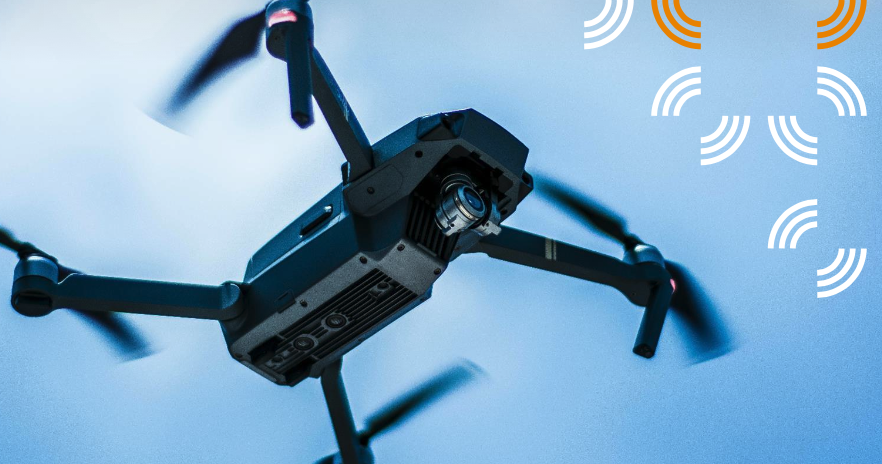

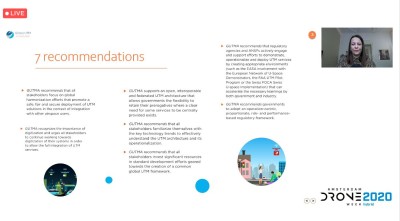
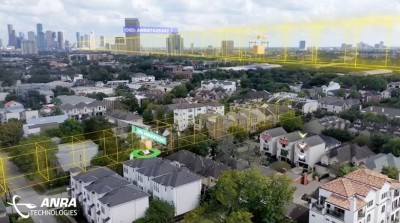










Comments